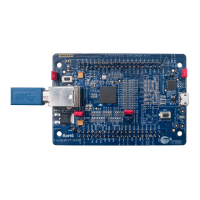EZ-USB FX3 Technical Reference Manual, Document Number: 001-76074 Rev. *F 21
Introduction to EZ-USB FX3
and link power management states and transitions. LTSSM consists of 12 states, including four operational link states (U0,
U1, U2, U3). The link layer offers these four link power states for better power management:
■ U0-Fully powered; link partners are fully powered and ready to send packets
■ U1-Standby with fast recovery; link is in a low-power state and is not ready to send packets but can transition back to U0
within microseconds
■ U2-Standby with slow recovery; link power saving is greater than U1 and transitioning back to U0 within microseconds to
milliseconds
■ U3-Suspend; greatest power savings and longest recovery back to U0 (milliseconds)
■ U1, U2, and U3 have increasingly longer wakeup times into U0 and thus allow transmitters to go into increasingly deeper
sleep.
■ Four link initialization and training states (Rx.Detect, Polling, Recovery, Hot Reset)
■ Two link test states (Loopback and Compliance mode)
■ SS.Inactive (link error state where USB 3.0 is nonoperable)
■ SS.Disabled (SuperSpeed bus is disabled and operates as USB 2.0 only)
Link commands are used to maintain the link flow control and to initiate a change in the link power state.
1.1.3 Protocol Layer
The protocol layer manages the communication rules between a host and device. The SuperSpeed protocol layer includes
the following improvements to enable better performance, efficiency, and power conservation. The information in this section
is provided as background material; the FX3 logic manages protocol details so the application program can deal directly with
USB data.
1.1.3.1 Unicast Transactions
SuperSpeed transactions are routed directly from a root port to the target device with the help of a route string in the packet
header. Therefore, only links in the direct path between the root port and target device see the traffic, which lets other links in
the topology enter or remain in a low-power state.
1.1.3.2 Token/ Data/Handshake Sequences
A USB 2.0 transaction consists of three packets: token, data, and handshake. A transaction is initiated with the token packet
and it is always from the host. Data packets deliver the payload data, which can be sourced by the host or device. The
handshake packet acknowledges the error-free receipt of data and is sent by the receiver of the data. But with SuperSpeed,
to save bandwidth, the token is incorporated into the data packet for OUT transactions; it is replaced by the handshake for IN
transactions. So an ACK packet acknowledges the previous data packet sent and requests the next data packet. The
following examples clarify the differences between USB 2.0 and USB 3.0 IN and OUT transactions.
1.1.3.2.1 IN Transaction Example
Figure 1-2 on page 22 illustrates the differences between USB 2.0 and SuperSpeed OUT transactions. The example on the
left in Figure 1-2 on page 22 shows the sequence of packets required to perform two USB 2.0 IN transactions that require six
packets:
1. Host broadcasts an IN token packet (1) to initiate the transaction.
2. Device returns the requested data packet (2).
3. Host acknowledges receipt of data with an ACK handshake packet (3).
4. Steps 1-3 are repeated.
The example on the right indicates the packet sequence necessary to perform two back-to-back SuperSpeed IN transactions,
which require only five packets to be exchanged:
1. SuperSpeed uses an ACK header (1) to initiate an IN transaction.
2. The SuperSpeed device returns the data packet (2).

